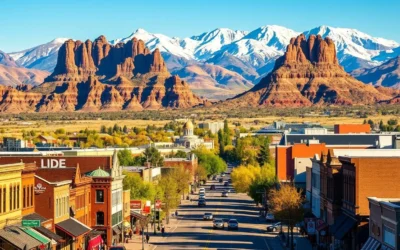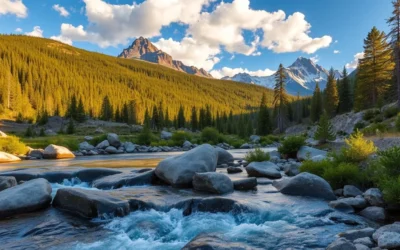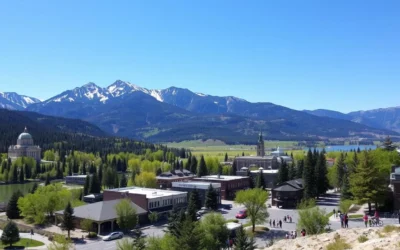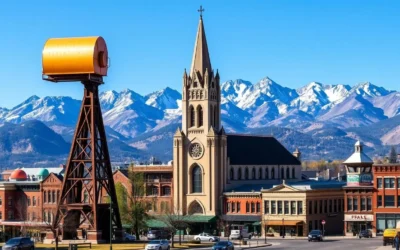Welcome to America’s first national park, a wonderland of geothermal activity, stunning landscapes, and abundant wildlife that draws millions of visitors each year.
As you explore this incredible destination, you’ll discover an array of natural wonders, from colorful hot springs to roaring waterfalls and vast canyons, spanning over 2 million acres with five park entrances.
From watching Old Faithful erupt to spotting bison in Lamar Valley, this comprehensive guide will walk you through the top attractions and must-do activities that make this experience unforgettable.
Whether you’re planning your first visit or returning to explore more, you’ll find the best things to do in this magnificent park to make the most of your adventure.
Discovering America’s First National Park
As the world’s first national park, Yellowstone National Park is a treasure trove of natural wonders waiting to be explored. You are about to embark on a journey through one of America’s most breathtaking destinations. Yellowstone is not just a park; it’s an experience that combines geological marvels, diverse wildlife, and rich history.
The Geological Wonder of Yellowstone
Yellowstone sits atop a volcanic hotspot where magma from deep beneath the Earth’s surface heats up groundwater, creating the park’s famous geysers, hot springs, and other geothermal features. The park is home to over 10,000 geothermal features, including the iconic Old Faithful, which is a must-see attraction. The unique geology of Yellowstone is a result of its location over a volcanic hotspot, making it a fascinating destination for scientists and tourists alike.
The geological wonders of Yellowstone are not limited to its geysers. The park’s diverse landscape, which includes volcanic mountains, canyons, and rivers, offers a visually stunning experience. As you explore the park, you’ll discover the intricate beauty of its geological formations, shaped by millions of years of volcanic activity and erosion.
Best Times to Visit Yellowstone
Planning your trip to Yellowstone requires considering the best time to visit, as the park experiences significant changes throughout the year. Summer is the peak tourist season, with warm temperatures and all facilities open, but it also means larger crowds and higher prices. If you’re looking for a more serene experience, consider visiting during the shoulder season.
In the fall, around September, the temperatures cool down, and the crowds start to diminish, making it an ideal time for those who prefer fewer tourists. By early October, the crowds are even smaller, and there’s a possibility of snowfall, adding a serene beauty to the park. Spring brings newborn wildlife and blooming wildflowers, though some roads and facilities may still be closed due to snow. Winter transforms the park into a snow-covered wonderland, perfect for cross-country skiing and snowshoeing.
- Summer (June through August): Warm temperatures, accessible trails, and all facilities open, but expect larger crowds and higher prices.
- Fall (September to early October): Spectacular colors, fewer visitors, and better wildlife viewing opportunities.
- Spring (May to early June): Newborn wildlife and blooming wildflowers, though some roads and facilities may still be closed.
- Winter (December through March): A snow-covered wonderland, ideal for cross-country skiing and snowshoeing, with limited access.
For the best balance of good weather and manageable crowds, consider visiting in late May/early June or September. These periods offer pleasant temperatures with fewer people, making your trip to Yellowstone National Park a memorable experience.
Planning Your Yellowstone Adventure
With so much to see and do in Yellowstone, planning your trip in advance is crucial to experiencing the best the park has to offer. Effective planning ensures that you make the most of your time and enjoy a stress-free vacation.
Getting Around the Park
Navigating Yellowstone can be a challenge due to its vast size and varied terrain. The park offers a range of transportation options, including a free shuttle service during peak season, which can help reduce traffic congestion and make it easier to get around. Additionally, there are numerous parking areas and scenic drives that allow you to explore the park’s many attractions.
For those who prefer to explore on their own, a detailed park map or app is essential for navigating the park’s roads and trails. Be sure to check the park’s website for up-to-date information on road closures and construction before you go.
Recommended Itineraries
With so many amazing sights to see in Yellowstone, creating an itinerary can help you prioritize your activities and make the most of your time. Consider allocating your days based on the park’s main attractions, such as Old Faithful, the Grand Prismatic Spring, and the Yellowstone Lake.
A sample itinerary might include spending a morning exploring the Upper Geyser Basin, followed by an afternoon hike on one of the park’s many trails, such as the Fairy Falls Trail or the Mount Washburn Trail.
Essential Gear for Yellowstone
Packing the right gear is crucial for a comfortable and enjoyable trip to Yellowstone. Here are some essentials to consider bringing:
- Layers for changing weather conditions, as temperatures can fluctuate dramatically between morning and afternoon.
- High-quality binoculars for wildlife viewing, allowing you to observe animals from a safe distance.
- Bear spray when hiking (available for purchase or rental in the park), and know how to use it properly.
- A good pair of hiking boots with ankle support for navigating the park’s varied terrain.
- Sun protection (hat, sunglasses, sunscreen), a reusable water bottle, and a detailed park map or app.
- Camera equipment with zoom lenses to capture memorable wildlife encounters and the park’s spectacular landscapes.
Old Faithful and Upper Geyser Basin
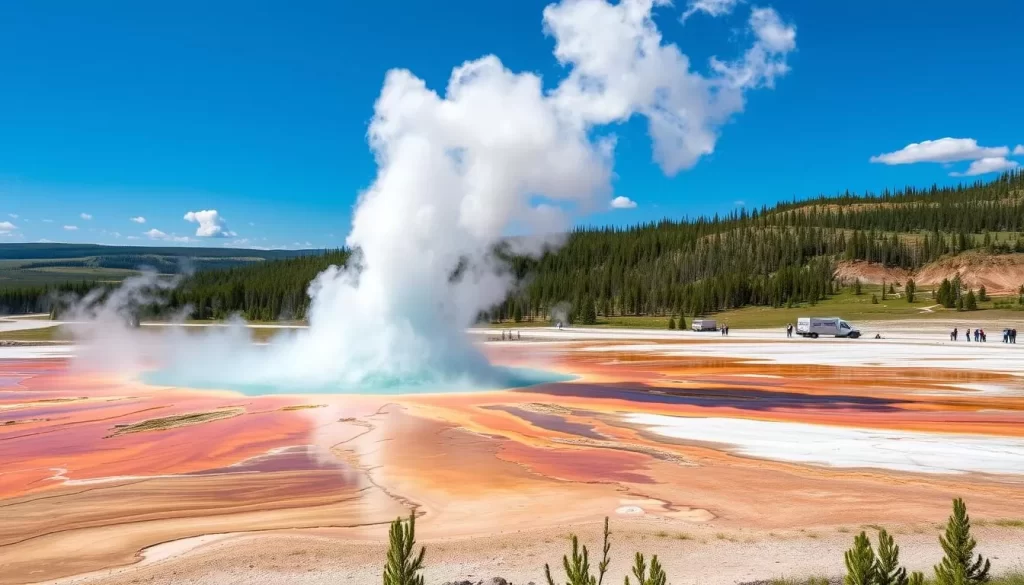
Yellowstone’s Upper Geyser Basin is a treasure trove of geothermal wonders, with Old Faithful being the star attraction. This area is a must-visit destination for anyone traveling to Yellowstone National Park, offering a unique glimpse into the park’s geothermal features.
Watching Old Faithful Erupt
Watching Old Faithful erupt is an unforgettable experience. The geyser erupts approximately every 90 minutes, although the exact timing can vary. Visitors can check the eruption schedule at the Old Faithful Visitor Education Center or through the park’s official app.
The eruptions are a spectacle, with water shooting up to 185 feet in the air. The surrounding area is well-developed, with boardwalks and viewing areas that allow visitors to safely observe this natural wonder.
Exploring the Upper Geyser Basin
The Upper Geyser Basin is home to numerous geothermal features, including hot springs, geysers, and fumaroles. Visitors can explore the area via a network of boardwalks and trails, getting up close to these natural wonders.
The basin is a geological wonder, with the geysers and hot springs creating a surreal landscape. The area is also rich in biodiversity, with various microorganisms thriving in the hot waters.
Morning Glory Pool
One of the highlights of the Upper Geyser Basin is the Morning Glory Pool, a vibrant hot spring known for its striking colors. The pool’s colors are a result of heat-loving bacteria that thrive in its waters.
To reach the Morning Glory Pool, visitors need to hike approximately 1.8 miles one way from Old Faithful along the boardwalk trail. Alternatively, using the Artemisia Trailhead can provide a shorter route and the opportunity to explore the neighboring Biscuit Basin.
Grand Prismatic Spring: Yellowstone’s Rainbow Wonder
As you step into Yellowstone, the Grand Prismatic Spring is a kaleidoscope of colors that will leave you awestruck. This natural wonder is the largest hot spring in the United States and one of the most photographed features in Yellowstone. The spring’s vibrant colors, created by the presence of microorganisms and minerals, are a true marvel of nature.
Midway Geyser Basin Boardwalk
The Midway Geyser Basin Boardwalk is a short, easy walk that takes you through the geothermal features of the Midway Geyser Basin, including the Grand Prismatic Spring. The boardwalk is designed to minimize the impact on the fragile ecosystem while providing visitors with an up-close experience of the spring’s beauty. As you walk along the boardwalk, you’ll be surrounded by the vibrant colors of the spring and other geothermal features.
Grand Prismatic Spring Overlook Trail
For a different perspective on the Grand Prismatic Spring, take the Grand Prismatic Spring Overlook Trail. This short hike offers a panoramic view of the spring from a raised overlook, providing a unique perspective on its size and color. The trail is relatively easy and is a great option for those who want to experience the spring from a different angle.
Best Time to Visit Grand Prismatic
The best time to visit Grand Prismatic Spring is between 10 AM and 3 PM on a sunny day when the colors are most vibrant. Early mornings often find the spring shrouded in mist that obscures its colors, while late afternoon can cast shadows across the spring. Summer visits provide the most intense colors as the warmer air temperatures reduce steam coverage. Be prepared for crowds during midday, especially in peak summer months (June-August). If you’re serious about photography, consider visiting in late May or September when crowds are thinner but colors remain impressive.
Visiting the Grand Prismatic Spring on a sunny day during midday will reward you with the most brilliant colors. While it’s the busiest time, the spectacle is worth the crowds. Plan your visit accordingly to make the most of your trip to this natural wonder.
The Historic Old Faithful Inn
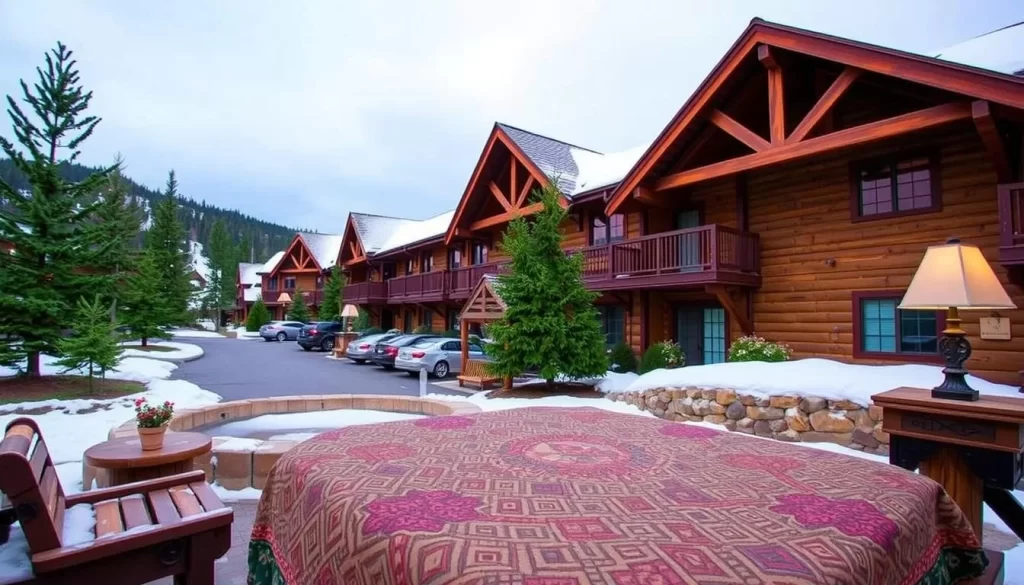
Nestled in the heart of Yellowstone National Park, the Old Faithful Inn stands as a testament to the region’s rich history and natural beauty. As you plan your visit to this iconic landmark, making Old Faithful Inn reservations in advance is highly recommended to ensure a seamless experience.
Architecture and History
The Old Faithful Inn is renowned for its unique architecture, which blends seamlessly into the surrounding landscape of Yellowstone National Park. Built in the early 20th century, the inn showcases a remarkable log framework that has withstood the test of time. As you explore the inn, you’ll discover the ingenuity behind its construction and the rich history it holds within its walls.
The inn’s design not only complements its natural surroundings but also offers a glimpse into the past, with stories of famous guests and the challenges faced in operating such a unique structure in the harsh Yellowstone environment.
The Exclusive Crow’s Nest Tour
For a truly unforgettable experience, consider taking the exclusive Crow’s Nest Tour at the Old Faithful Inn. This tour is one of Old Faithful‘s best-kept secrets, offering a unique perspective on the inn’s architecture and the surrounding geyser basin.
The Crow’s Nest is a small observation platform located near the top of the inn, providing panoramic views of the area. The tour includes fascinating stories about the inn’s history and allows you to witness Old Faithful eruptions from a unique elevated perspective.
Grand Canyon of the Yellowstone
As you stand at the edge of the Grand Canyon of the Yellowstone, the vast expanse unfolds before you. The canyon, carved by the Yellowstone River, is a breathtaking example of the natural forces that have shaped Yellowstone National Park over millions of years.
North Rim Highlights
The North Rim of the Grand Canyon offers several viewpoints and trails that provide stunning vistas of the canyon and the Lower Falls. Visitors can enjoy a leisurely walk along the rim or take on more challenging hikes that descend into the canyon.
| Trail | Distance | Difficulty |
|---|---|---|
| North Rim Trail | 2 miles | Moderate |
| Seven Mile Hole Trail | 7 miles | Strenuous |
South Rim and Artist Point
The South Rim is home to Artist Point, one of the most photographed viewpoints in Yellowstone. Here, you can witness the majestic Lower Falls plunging 308 feet into the canyon below. The trail to Artist Point is relatively easy and offers an unforgettable experience.
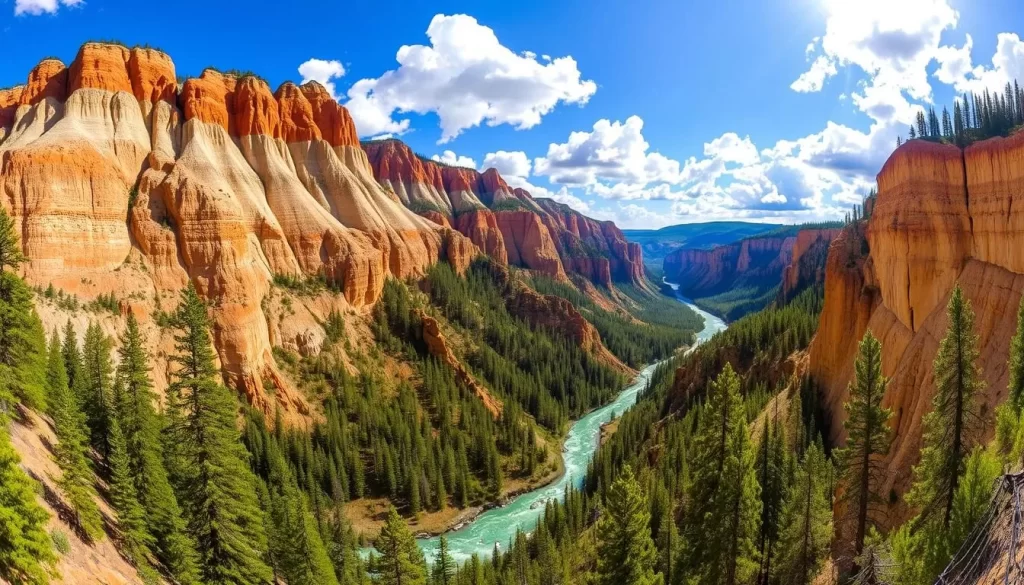
Uncle Tom’s Trail
For a more adventurous experience, consider hiking Uncle Tom’s Trail, which descends 328 metal stairs from the South Rim down into the Grand Canyon. This strenuous but rewarding trail brings you closer to the base of the Lower Falls and offers a unique perspective on the power of the Yellowstone River.
- Descends 328 metal stairs to the base of Lower Falls
- Offers a unique perspective on the 308-foot waterfall
- Named after “Uncle Tom” Richardson, who guided visitors in the late 1890s
- Be prepared for a challenging climb back up
Wildlife Viewing in Yellowstone National Park, Montana: Best Things to Do
As you explore Yellowstone National Park, you’ll have the chance to witness incredible wildlife, from majestic bison to elusive wolves. The park is renowned for its diverse range of animals, offering numerous opportunities for wildlife viewing. With its rich biodiversity, Yellowstone provides a unique setting for observing wildlife in their natural habitats.
Lamar Valley: The American Serengeti
Lamar Valley, often referred to as the “American Serengeti,” is a prime location for wildlife viewing. This vast valley is home to an abundance of wildlife, including wolves, bears, and elk. Visitors can drive through the valley and observe these animals roaming freely in their natural habitat. The valley’s open spaces and diverse wildlife make it a must-visit destination for anyone interested in wildlife viewing.
- Look out for wolves, especially during the early morning and late evening.
- Observe the valley’s diverse birdlife, including eagles and hawks.
- Keep a safe distance from wildlife, using binoculars for a closer view.
Hayden Valley Wildlife
Hayden Valley is another hotspot for wildlife enthusiasts. The valley is known for its grizzly bears, wolves, and bison. Visitors can explore the valley by driving through it, keeping an eye out for these incredible animals. The valley’s unique geology and diverse wildlife make it an exciting place to explore.
When visiting Hayden Valley, be sure to:
- Stay in your vehicle to ensure safety.
- Be patient and keep your eyes peeled for wildlife.
- Enjoy the scenic views and diverse landscapes.
Wildlife Safety Tips
While wildlife viewing is a thrilling experience, it’s crucial to maintain a safe distance from the animals. Here are some essential wildlife safety tips:
- Always maintain a minimum distance of 100 yards (91 meters) from bears and wolves, and 25 yards (23 meters) from all other wildlife, including bison and elk.
- Never approach, feed, or attempt to touch any wild animal, no matter how docile they may appear.
- Stay in your vehicle when viewing roadside wildlife, using pullouts to avoid blocking traffic on park roads.
- Carry bear spray and know how to use it when hiking in bear country, making noise while on trails to avoid surprising bears.
- If a bison or elk raises its tail, paws the ground, or makes grunting noises, these are warning signs that you’re too close and should back away immediately.
By following these guidelines, you can enjoy a safe and memorable wildlife viewing experience in Yellowstone National Park. The park offers a unique opportunity to observe a wide range of wildlife in their natural habitats, making it a must-visit destination for nature enthusiasts.
Mammoth Hot Springs
As you explore Yellowstone National Park, a visit to Mammoth Hot Springs is a must, offering a unique blend of natural wonder and historical significance. The area is known for its travertine formations and the historic Fort Yellowstone.
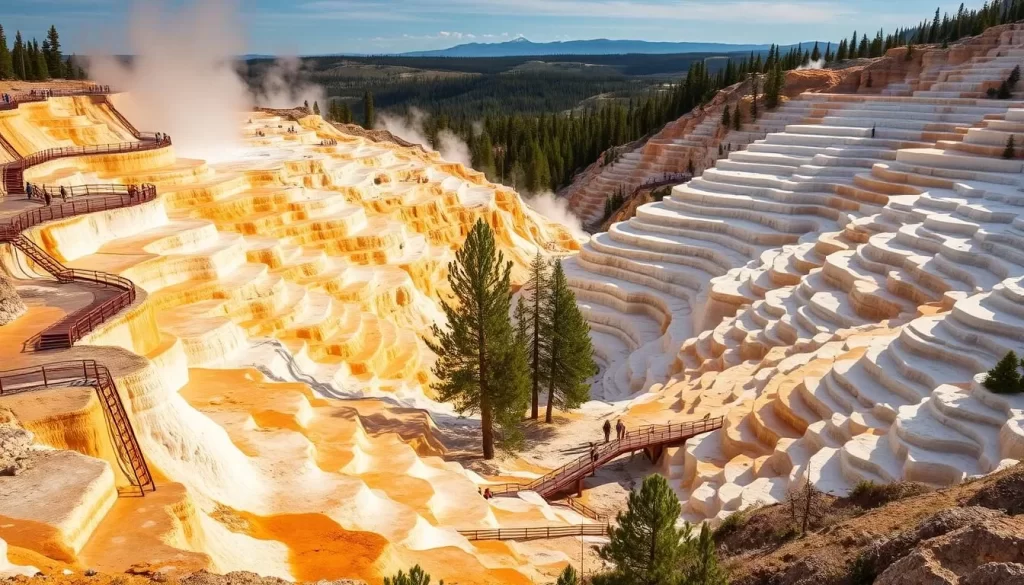
Travertine Terraces
The travertine terraces at Mammoth Hot Springs are a breathtaking sight. These formations are created by the precipitation of calcium carbonate from the hot spring water. As you walk along the boardwalk trails, you’ll be surrounded by the vibrant colors and intricate patterns of the travertine.
A visit here can be tailored to your pace, whether that’s a quick glance from one or two viewpoints or a more leisurely stroll along the boardwalks that wind past each viewpoint. The complex of hot springs and travertine formations is as beautiful as it is fascinating.
| Feature | Description |
|---|---|
| Travertine Formation | Created by calcium carbonate precipitation from hot spring water |
| Boardwalk Trails | Allow visitors to explore the travertine terraces up close |
| Viewpoints | Multiple vantage points for observing the hot springs and travertine |
Historic Fort Yellowstone
Located within the Mammoth Hot Springs area, Fort Yellowstone is a significant historical site that served as the U.S. Army headquarters during their administration of Yellowstone from 1886 to 1918. The fort complex comprises more than 35 historic structures, many of which now serve as National Park Service offices and employee housing.
You can take a self-guided tour of the fort using the interpretive signs that explain the history of each building and the military’s role in protecting the park. The Albright Visitor Center, housed in the former bachelor officers’ quarters, offers exhibits on park history and the role of the U.S. Army in Yellowstone.
- The parade ground at the center of Fort Yellowstone is often home to grazing elk, especially during fall and spring, adding a touch of wildlife to the historic setting.
- The fort’s historic structures provide a glimpse into the past, showcasing the military’s administrative and residential quarters.
Visiting Mammoth Hot Springs offers a blend of natural beauty and historical insight, making it a compelling part of any Yellowstone National Park itinerary. Whether you’re drawn to the geological wonders or the historical significance, Mammoth Hot Springs is a park highlight that shouldn’t be missed.
Norris Geyser Basin
Your Yellowstone adventure isn’t complete without visiting Norris Geyser Basin, a true natural marvel. As the hottest and most dynamic of Yellowstone’s geyser basins, Norris offers an unparalleled geothermal experience. This area is a testament to the park’s unique volcanic features, making it a fascinating destination for visitors.
Porcelain Basin
The Porcelain Basin is one of the two main areas of Norris Geyser Basin, known for its vibrant colors and diverse geothermal features. As you walk along the boardwalk, you’ll be surrounded by an otherworldly landscape of geysers, hot springs, and fumaroles. The basin’s name comes from the white, porcelain-like appearance of the ground, created by the presence of silica-rich waters.
The area is relatively barren, which adds to its surreal beauty. You can witness the powerful forces at work beneath the surface, with steam and hot water creating a dynamic display. Be sure to stay on the designated paths to ensure your safety while taking in the breathtaking scenery.
Back Basin and Steamboat Geyser
In contrast to the Porcelain Basin, the Back Basin is more forested, with thermal features nestled among lodgepole pines. This larger basin is home to Steamboat Geyser, the world’s tallest active geyser. When Steamboat erupts, it can shoot water more than 300 feet into the air, a sight that is both rare and awe-inspiring.
- The unpredictability of Steamboat’s major eruptions makes it a thrilling experience, with eruptions occurring days, weeks, or even years apart.
- A 1.5-mile boardwalk loop takes you through the Back Basin, featuring other fascinating geothermal features like Emerald Spring, Cistern Spring, and Echinus Geyser.
- Even without a major eruption, Steamboat regularly has minor eruptions, shooting water 10-40 feet high, ensuring there’s always something to see.
Visiting Norris Geyser Basin provides a unique insight into Yellowstone’s geothermal wonders, making it an essential part of your park experience.
Scenic Drives Through Yellowstone
Yellowstone’s scenic drives offer a unique way to experience the park’s diverse geological features. As you explore the park, you’ll have the opportunity to witness breathtaking landscapes, geysers, and hot springs up close.
Dunraven Pass
Dunraven Pass is a scenic drive that takes you through a diverse range of landscapes, from lush forests to open meadows. This drive offers stunning views and is a great way to spot wildlife, including elk and bears. Be sure to stop at the Dunraven Pass trailhead, which provides access to several hiking trails.
Blacktail Plateau Drive
The Blacktail Plateau Drive is a 7-mile loop that takes you through a unique volcanic landscape. This drive features petrified trees and offers insights into the park’s geological history. The plateau is also known for its wildflower displays during the spring and summer months.
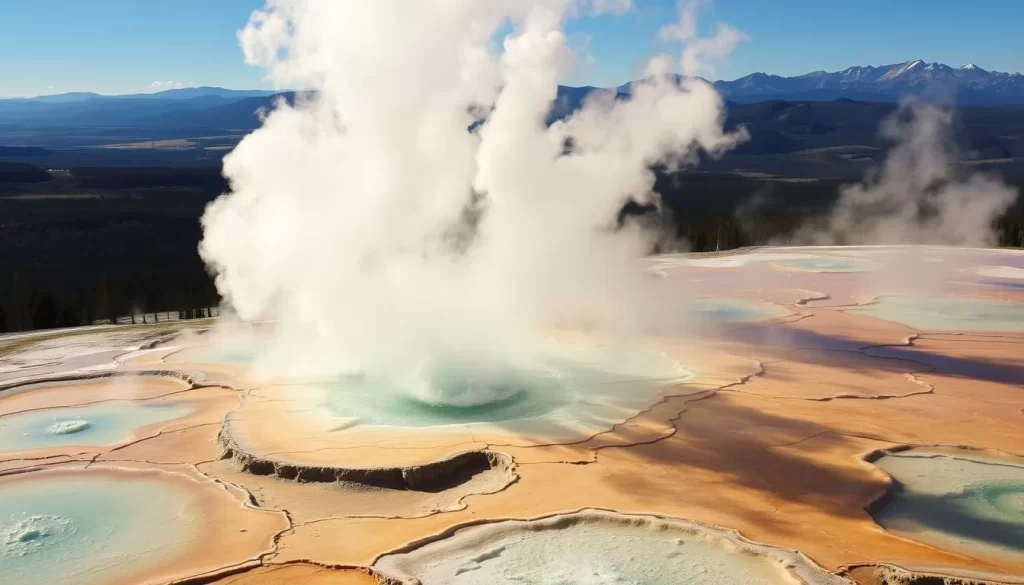
| Scenic Drive | Distance | Notable Features |
|---|---|---|
| Dunraven Pass | 14 miles | Wildlife viewing, hiking trails |
| Blacktail Plateau Drive | 7 miles | Petrified trees, wildflowers |
| Firehole Lake Drive | 3 miles (one-way) | Geysers, hot springs |
Firehole Lake Drive
Firehole Lake Drive is a 3-mile, one-way side road that showcases some of Yellowstone’s most impressive geysers and hot springs, away from the main crowds. The highlight of this scenic drive is the Great Fountain Geyser, which erupts every 9-15 hours, shooting water up to 220 feet in the air. Other notable features along the route include White Dome Geyser, Pink Cone Geyser, and Firehole Spring. Early morning or evening visits offer the best lighting for photography and the possibility of seeing the thermal features with fewer visitors.
These scenic drives not only provide a glimpse into Yellowstone’s natural wonders but also offer an enjoyable way to explore the park’s diverse landscapes. Whether you’re interested in geology, wildlife, or simply taking in the views, Yellowstone’s scenic drives have something for everyone.
Best Hikes in Yellowstone
With its vast wilderness and unique geological features, Yellowstone is a hiker’s paradise. The park offers a wide range of trails that cater to different skill levels and interests, ensuring that every visitor can find a hike that suits their preferences.
Fairy Falls Trail
The Fairy Falls Trail is a popular destination for hikers, offering a moderately easy 7-mile round-trip journey to the Fairy Falls, a 197-foot waterfall. The trail begins at the Fairy Falls Trailhead, located near the Grand Prismatic Spring. Hikers are rewarded with stunning views of the falls and the surrounding meadows.
Mount Washburn
For those seeking a more challenging hike, Mount Washburn offers a strenuous 6-mile round-trip climb to the summit. The trailhead is located near the Mount Washburn Trailhead, and hikers can enjoy panoramic views of the surrounding landscape from the top.
Storm Point and Elephant Back Mountain
Storm Point and Elephant Back Mountain offer a unique hiking experience, with trails that provide stunning views of Yellowstone Lake and the surrounding mountains. The trails are relatively easy, making them accessible to hikers of various skill levels.
Mystic Falls Trail
The Mystic Falls Trail is a 3.6-mile loop that begins at Biscuit Basin, taking you to a beautiful 70-foot cascade on the Little Firehole River. The trail offers two options: a shorter out-and-back route directly to the falls, or a more scenic loop that includes an overlook of the Upper Geyser Basin. Taking the loop clockwise provides a gradual ascent to the overlook followed by a steeper descent to the falls, offering varied terrain and views. The waterfall is surrounded by a beautiful canyon with columnar basalt formations, creating a picturesque setting.
| Trail Name | Distance | Difficulty |
|---|---|---|
| Fairy Falls Trail | 7 miles round-trip | Moderate |
| Mount Washburn | 6 miles round-trip | Strenuous |
| Mystic Falls Trail | 3.6 miles loop | Moderate |
These trails represent just a few of the many hiking opportunities available in Yellowstone. Whether you’re looking for a leisurely stroll or a more challenging adventure, the park has something to offer.
Yellowstone Lake Activities
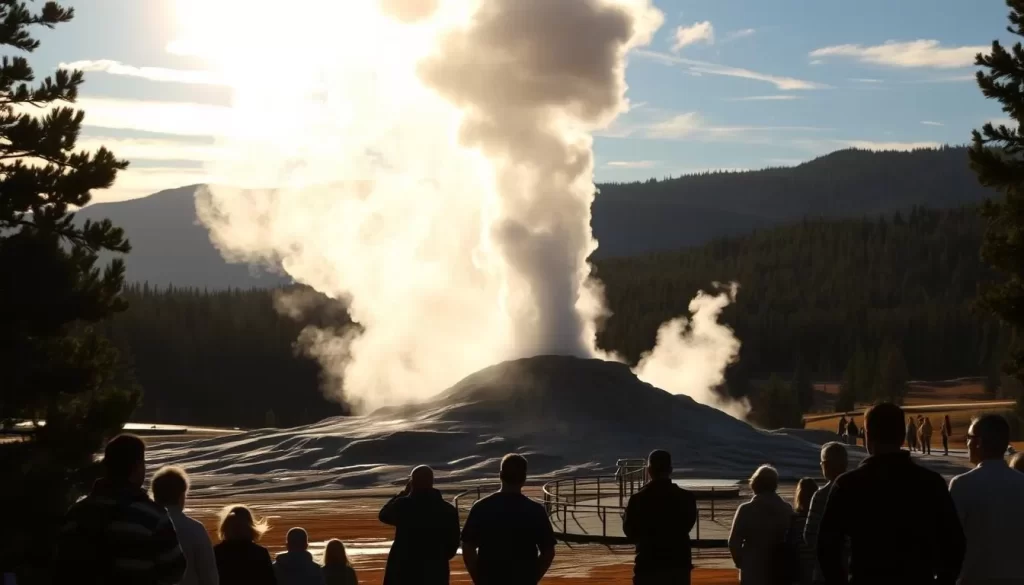
Yellowstone Lake, the largest high-altitude lake in North America, is a must-visit destination for outdoor enthusiasts and nature lovers alike. The lake offers a variety of activities that allow you to immerse yourself in its natural beauty.
Boating and Fishing
Boating and fishing are among the most popular activities on Yellowstone Lake. You can rent boats or bring your own to explore the lake’s vast waters. Fishing is a great way to experience the lake’s diverse aquatic life, with species such as trout and whitefish being common catches. Make sure to follow park regulations and obtain any necessary permits before you start fishing.
West Thumb Geyser Basin
Located on the shores of Yellowstone Lake, the West Thumb Geyser Basin is a unique geothermal area that offers a fascinating contrast between the lake’s cool waters and the hot springs. This relatively small basin can be explored via a half-mile boardwalk loop, making it an ideal stop for visitors. Highlights include the Abyss Pool, one of the deepest hot springs in Yellowstone, and Fishing Cone, a geyser where early visitors would catch and cook fish simultaneously.
The West Thumb Geyser Basin is not only a visual treat but also a great spot for learning about Yellowstone’s geothermal features. The basin’s colorful hot springs and pools are set against the stunning backdrop of Yellowstone Lake, creating spectacular photo opportunities. It’s conveniently located on the road between Grant Village and Lake Village, making it an easy stop when traveling between these areas.
Lesser-Known Thermal Features
Beyond the famous geysers and hot springs, Yellowstone hides a treasure trove of lesser-known thermal features waiting to be explored. These hidden gems offer a unique perspective on the park’s geothermal wonders, providing visitors with an opportunity to experience the natural beauty of Yellowstone without the crowds.
Artist Paintpots
Located in the Gibbon Geyser Basin, Artist Paintpots is a lesser-known thermal area that showcases a vibrant display of colorful hot springs and mud pots. The site gets its name from the multicolored hues of the mud and rocks, reminiscent of an artist’s palette. A short, half-mile walk on a boardwalk trail takes you through this unique thermal area, where you can observe the fascinating geological processes that shape Yellowstone’s landscape.
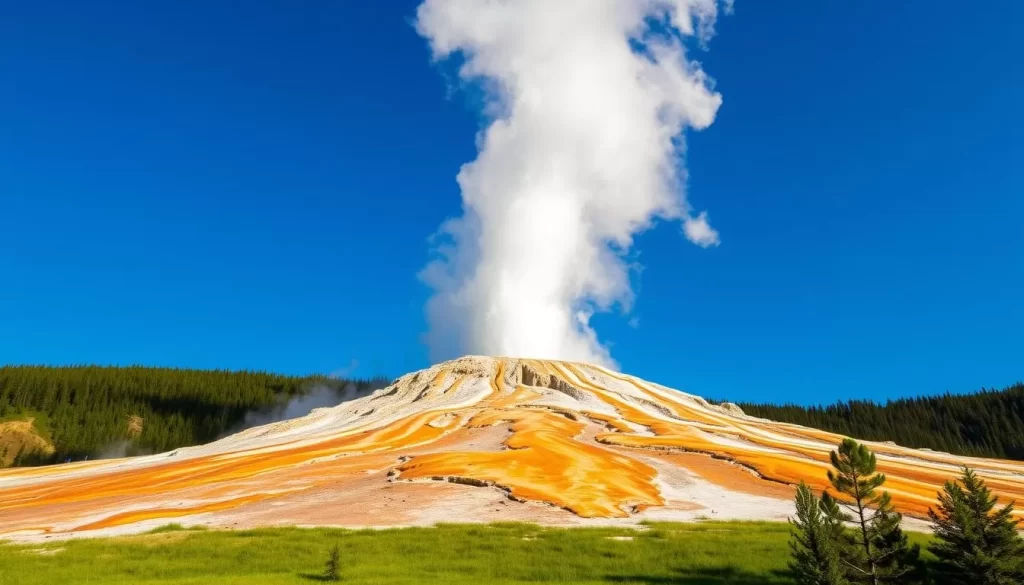
Mud Volcano and Dragon’s Mouth Spring
The Mud Volcano area is another lesser-known thermal feature in Yellowstone, characterized by its bubbling mud pots and the intriguing Dragon’s Mouth Spring. The Mud Volcano area is a result of the park’s unique geology, where hot water and gases interact with the surrounding rocks, creating a surreal landscape. Dragon’s Mouth Spring is a fascinating feature that emits a hissing sound, adding to the area’s mystique.
Fountain Paint Pot
Fountain Paint Pot is a compact thermal area that showcases all four types of hydrothermal features found in Yellowstone: hot springs, geysers, fumaroles, and mud pots. The half-mile boardwalk loop is perfect for visitors wanting to experience Yellowstone’s thermal diversity without spending hours walking. You can witness the area’s largest geyser, Fountain Geyser, erupting every 4-12 hours, shooting water up to 100 feet high for approximately 30 minutes.
These lesser-known thermal features not only provide a unique experience but also offer insights into the geological processes that shape Yellowstone National Park. By exploring these areas, you can gain a deeper appreciation for the park’s natural wonders and the complex interactions between water, rock, and heat that create its diverse geothermal features.
Where to Stay in Yellowstone
Your Yellowstone adventure starts with choosing where to stay, whether it’s within the park or in nearby towns. Yellowstone National Park offers a range of accommodations to suit different preferences and needs.
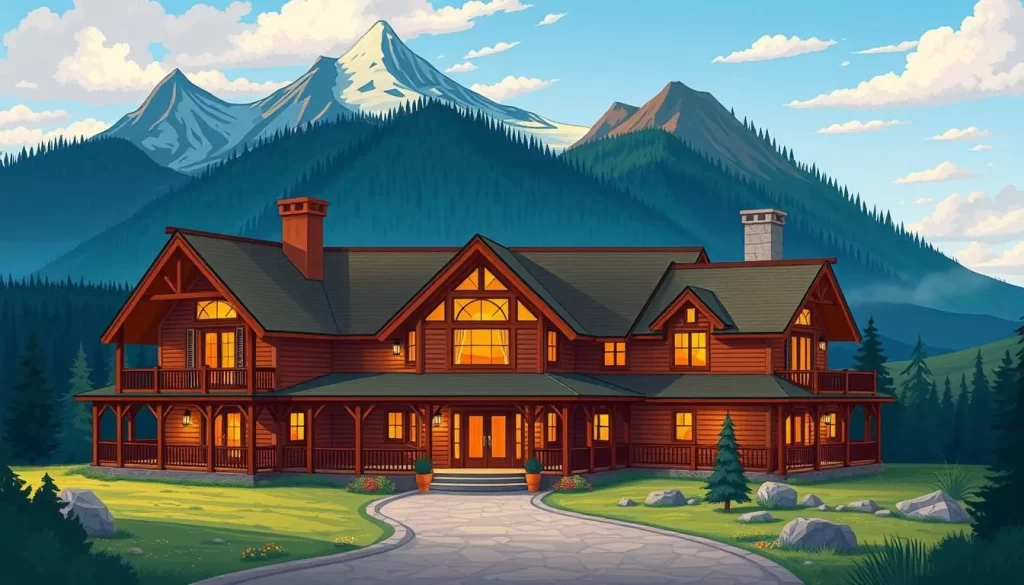
In-Park Lodging Options
Staying within Yellowstone National Park can enhance your experience, allowing you to be closer to the park’s natural wonders. The park offers several lodging options, ranging from historic hotels like the Old Faithful Inn to more rustic cabins and lodges.
These in-park lodgings provide a unique experience, with some offering stunning views and easy access to major attractions. Booking in advance is essential, especially during peak season, as these lodgings tend to fill up quickly.
Campgrounds in Yellowstone
For those who prefer camping, Yellowstone has numerous campgrounds that offer a more immersive experience with nature. From developed campgrounds with amenities to backcountry sites for a more primitive experience, there’s something for every camper.
Camping in Yellowstone allows you to be surrounded by the park’s breathtaking landscapes and wildlife. It’s a great way to connect with nature and enjoy the park’s serene environments.
Gateway Towns
If in-park accommodations are not available, or if you prefer to stay outside the park, the gateway towns near Yellowstone are excellent alternatives. West Yellowstone, Montana, at the west entrance, and Gardiner, Montana, at the north entrance, are particularly convenient.
West Yellowstone offers a wide range of accommodations, restaurants, and services, making it a great base for your trip. Gardiner, on the other hand, provides year-round access to the park and is a gateway to Mammoth Hot Springs. Both towns offer a unique experience and are a great way to enjoy Yellowstone.
Unique Yellowstone Experiences
Beyond its geysers and hot springs, Yellowstone provides numerous distinctive experiences that allow visitors to connect with nature on a deeper level. Whether you’re interested in guided tours, educational programs, or simply taking in the natural beauty, Yellowstone has something for everyone.
Ranger-Led Programs
During the summer months, Yellowstone offers a variety of ranger-led programs designed to educate and engage visitors. These programs cover a range of topics, from the park’s geological features to its diverse wildlife. By participating in these programs, you can gain a deeper understanding of the park’s natural and cultural history.
Some of the programs are interactive and allow for a hands-on experience, making them particularly enjoyable for families. Be sure to check the park’s schedule for program times and locations.
Wildlife Tours with Expert Guides
For a more in-depth look at Yellowstone’s wildlife, consider joining a wildlife tour led by an expert guide. These tours provide a unique opportunity to observe animals in their natural habitats, from bison and elk to bears and wolves. Guides are knowledgeable about the behavior and habitats of the animals, offering insights that enhance your wildlife viewing experience.
The Lake Yellowstone Hotel, for example, hosts live music each evening, creating a relaxing atmosphere after a day of exploring. This blend of natural beauty and cultural enrichment is a hallmark of the Yellowstone experience.
Stargazing in Yellowstone
Yellowstone’s remote location and minimal light pollution make it an ideal destination for stargazing. On clear nights, the park’s dark skies reveal a breathtaking array of stars. During the summer, ranger-led astronomy programs are occasionally available, offering insights into constellations and the opportunity to view celestial objects through telescopes.
Some of the best locations for stargazing include Hayden Valley, Lake Butte Overlook, and Swan Lake Flat. Remember to bring warm clothing, as temperatures can drop significantly after sunset, even in the summer. For photography enthusiasts, the geothermal features provide unique foreground elements for capturing the night sky.
Conclusion: Making the Most of Your Yellowstone Adventure
With its unparalleled natural beauty, Yellowstone National Park is a destination that promises to leave you in awe. As you’ve explored the various attractions and activities within the park, it’s clear that Yellowstone offers an unforgettable experience.
One of the key takeaways from planning your trip to Yellowstone is the importance of taking your time to explore beyond the most famous attractions. The park’s diverse natural wonders, from geothermal features to abundant wildlife, reward visitors who venture off the beaten path.
To make the most of your visit, consider the following tips:
- Plan for at least 4-5 days in the park to experience its highlights without feeling rushed.
- Visit during the shoulder seasons (May-June or September-early October) to enjoy fewer crowds.
- Be prepared for the unpredictable nature of Yellowstone, where unexpected moments can become the most memorable experiences.
- Take time to disconnect from technology and immerse yourself in the natural surroundings.
As you reflect on your journey, remember that Yellowstone National Park is not just a destination, but an ongoing conservation story. The world’s first national park continues to teach us about the importance of preserving wild places for future generations.
Whether you’re drawn to the geothermal wonders, the abundant wildlife, or the spectacular landscapes, Yellowstone offers something magical for every visitor willing to slow down and appreciate its natural splendor. As you conclude your trip, you’ll likely find that the best things about Yellowstone are the experiences that stay with you long after you leave.
The above is subject to change.
Check back often to TRAVEL.COM for the latest travel tips and deals.

